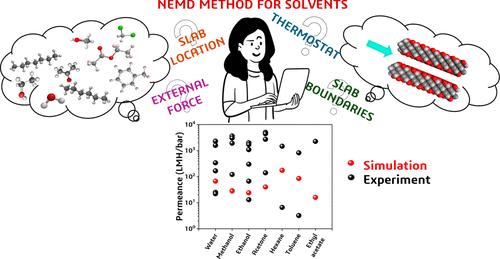当前位置:
X-MOL 学术
›
J. Chem. Theory Comput.
›
论文详情
Our official English website, www.x-mol.net, welcomes your
feedback! (Note: you will need to create a separate account there.)
Guide for Nonequilibrium Molecular Dynamics Simulations of Organic Solvent Transport in Nanopores: The Case of 2D MXene Membranes
Journal of Chemical Theory and Computation ( IF 5.7 ) Pub Date : 2024-11-04 , DOI: 10.1021/acs.jctc.4c00693 Aysa Güvensoy-Morkoyun, Tuğba Baysal, Ş. Birgül Tantekin-Ersolmaz, Sadiye Velioğlu
Journal of Chemical Theory and Computation ( IF 5.7 ) Pub Date : 2024-11-04 , DOI: 10.1021/acs.jctc.4c00693 Aysa Güvensoy-Morkoyun, Tuğba Baysal, Ş. Birgül Tantekin-Ersolmaz, Sadiye Velioğlu

|
Organic solvent nanofiltration (OSN) stands out as an energy-efficient and low-carbon footprint technology, currently reliant on polymeric membranes. With their exceptional chemical stability and tunable sieving properties, two-dimensional (2D) nanolaminate membranes present distinct advantages over conventional polymer-based membranes, attracting tremendous interest in the OSN community. Computational approaches for designing innovative 2D nanolaminates exhibit significant potential for the future of OSN technology. Imitating the pressure gradient in filtration processes by applying an external force to atoms within a predefined slab, boundary-driven nonequilibrium molecular dynamics ((BD)-NEMD) is a state-of-the-art simulation method with a proven track record in investigating the water transport in nanopores. Nevertheless, implementation of (BD)-NEMD for a broad range of solvents poses a challenge in estimating the OSN performance of theoretical membranes. In this work, we developed a (BD)-NEMD protocol that elucidates the effects of several computational details often overlooked in water simulations but are crucial for bulky solvent systems. We employed a MXene (Ti3C2O2) nanochannel as a model membrane and examined the transport of nine solvents (methanol, ethanol, acetone, n-hexane, n-heptane, toluene, ethyl acetate, dichloromethane, and water) having different properties. First, the impact of ensemble type, thermostatting, channel wall model, and restraining force constant was elaborated. After optimizing the thermostatting approach, we demonstrated that the location of the force slab particularly affects the flux of bulky solvents by changing the density distribution in the feed and permeate sides. Similarly, the uniformity of intramolecular force distribution in bulky solvents and resulting flux are shown to be prone to manipulation by slab boundaries. Next, the magnitudes of the external force generating a linear relation between the pressure gradient and solvent flux were identified for each solvent to ensure that calculated fluxes could be extrapolated to experimentally related pressures. This linear relation was also validated for a mixture system containing 50% ethanol and 50% water. We then correlated the calculated solvent permeances with various solvent properties, such as viscosity, Hansen solubility parameters, kinetic diameter, and interaction energy. Remarkably, we observed a linear correlation with an R2 value of 0.96 between permeance and the combined parameter of viscosity and interaction energy. Finally, the solvent permeances calculated with our proposed methodology closely align with the experimentally reported data. Overall, our work aims to serve as a practical guide and bridge the gap in established simulation methods that are suited for a broad range of solvents and membrane materials.
中文翻译:

纳米孔中有机溶剂传输的非平衡分子动力学模拟指南:以 2D MXene 膜为例
有机溶剂纳滤 (OSN) 是一种节能且低碳的技术,目前依赖于聚合物膜。二维 (2D) 纳米层压膜具有卓越的化学稳定性和可调的筛分性能,与传统的聚合物基膜相比具有明显的优势,引起了 OSN 界的极大兴趣。用于设计创新 2D 纳米层压板的计算方法对 OSN 技术的未来具有巨大潜力。边界驱动的非平衡分子动力学 ((BD)-NEMD) 通过对预定义板内的原子施加外力来模拟过滤过程中的压力梯度,是一种最先进的模拟方法,在研究纳米孔中的水传输方面有着良好的记录。然而,在广泛的溶剂中实施 (BD)-NEMD 对估计理论膜的 OSN 性能提出了挑战。在这项工作中,我们开发了一种 (BD)-NEMD 协议,该协议阐明了水模拟中经常被忽视但对于大型溶剂系统至关重要的几个计算细节的影响。我们采用 MXene (Ti3C2O2) 纳米通道作为模型膜,并检查了九种具有不同性质的溶剂(甲醇、乙醇、丙酮、正己烷、正庚烷、甲苯、乙酸乙酯、二氯甲烷和水)的传输。首先,阐述了系综类型、恒温、渠道壁模型和约束力常数的影响。在优化了恒温方法后,我们证明了力板的位置通过改变进料侧和渗透侧的密度分布来特别影响大体积溶剂的通量。 同样,在大体积溶剂中分子内力分布的均匀性以及由此产生的磁通量很容易受到板坯边界的操纵。接下来,确定每种溶剂在压力梯度和溶剂通量之间产生线性关系的外力的大小,以确保计算出的通量可以外推到实验相关的压力。这种线性关系也对含有 50% 乙醇和 50% 水的混合系统进行了验证。然后,我们将计算出的溶剂渗透率与各种溶剂性质相关联,例如粘度、Hansen 溶解度参数、动力学直径和相互作用能。值得注意的是,我们观察到磁导率与粘度和相互作用能的组合参数之间存在线性相关性,R 2 值为 0.96。最后,使用我们提出的方法计算的溶剂渗透率与实验报告的数据非常一致。总体而言,我们的工作旨在作为实用指南,并弥合适用于各种溶剂和膜材料的既定模拟方法的差距。
更新日期:2024-11-04
中文翻译:

纳米孔中有机溶剂传输的非平衡分子动力学模拟指南:以 2D MXene 膜为例
有机溶剂纳滤 (OSN) 是一种节能且低碳的技术,目前依赖于聚合物膜。二维 (2D) 纳米层压膜具有卓越的化学稳定性和可调的筛分性能,与传统的聚合物基膜相比具有明显的优势,引起了 OSN 界的极大兴趣。用于设计创新 2D 纳米层压板的计算方法对 OSN 技术的未来具有巨大潜力。边界驱动的非平衡分子动力学 ((BD)-NEMD) 通过对预定义板内的原子施加外力来模拟过滤过程中的压力梯度,是一种最先进的模拟方法,在研究纳米孔中的水传输方面有着良好的记录。然而,在广泛的溶剂中实施 (BD)-NEMD 对估计理论膜的 OSN 性能提出了挑战。在这项工作中,我们开发了一种 (BD)-NEMD 协议,该协议阐明了水模拟中经常被忽视但对于大型溶剂系统至关重要的几个计算细节的影响。我们采用 MXene (Ti3C2O2) 纳米通道作为模型膜,并检查了九种具有不同性质的溶剂(甲醇、乙醇、丙酮、正己烷、正庚烷、甲苯、乙酸乙酯、二氯甲烷和水)的传输。首先,阐述了系综类型、恒温、渠道壁模型和约束力常数的影响。在优化了恒温方法后,我们证明了力板的位置通过改变进料侧和渗透侧的密度分布来特别影响大体积溶剂的通量。 同样,在大体积溶剂中分子内力分布的均匀性以及由此产生的磁通量很容易受到板坯边界的操纵。接下来,确定每种溶剂在压力梯度和溶剂通量之间产生线性关系的外力的大小,以确保计算出的通量可以外推到实验相关的压力。这种线性关系也对含有 50% 乙醇和 50% 水的混合系统进行了验证。然后,我们将计算出的溶剂渗透率与各种溶剂性质相关联,例如粘度、Hansen 溶解度参数、动力学直径和相互作用能。值得注意的是,我们观察到磁导率与粘度和相互作用能的组合参数之间存在线性相关性,R 2 值为 0.96。最后,使用我们提出的方法计算的溶剂渗透率与实验报告的数据非常一致。总体而言,我们的工作旨在作为实用指南,并弥合适用于各种溶剂和膜材料的既定模拟方法的差距。


















































 京公网安备 11010802027423号
京公网安备 11010802027423号